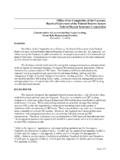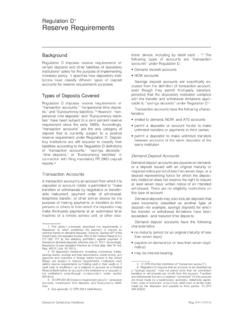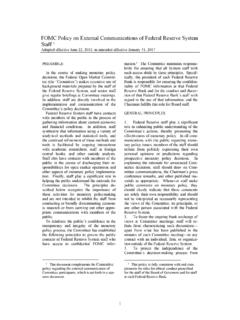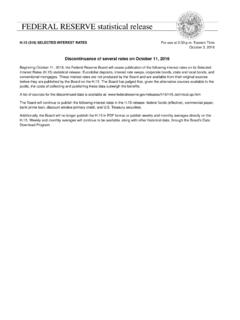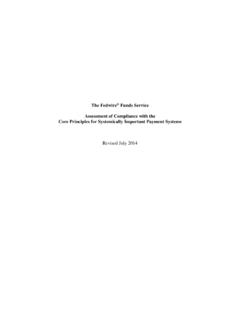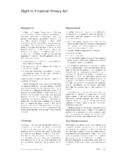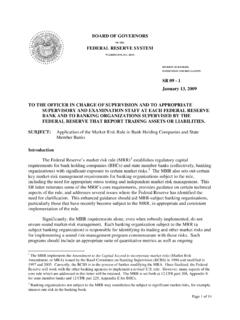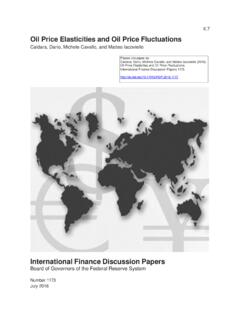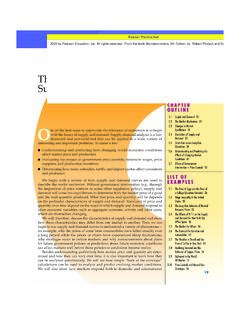Transcription of Aggregate Demand and Aggregate Supply Effects of …
1 Finance and Economics Discussion Series Divisions of Research & Statistics and Monetary Affairs Federal Reserve Board, Washington, Aggregate Demand and Aggregate Supply Effects of COVID-19: A Real-time Analysis Geert Bekaert, Eric Engstrom, Andrey Ermolov 2020-049. Please cite this paper as: Bekaert, Geert, Eric Engstrom, and Andrey Ermolov (2020). Aggregate Demand and Aggregate Supply Effects of COVID-19: A Real-time Analysis, Finance and Economics Discussion Series 2020-049. Washington: Board of Governors of the Federal Reserve System, NOTE: Staff working papers in the Finance and Economics Discussion Series (FEDS) are preliminary materials circulated to stimulate discussion and critical comment.
2 The analysis and conclusions set forth are those of the authors and do not indicate concurrence by other members of the research staff or the Board of Governors. References in publications to the Finance and Economics Discussion Series (other than acknowledgement) should be cleared with the author(s) to protect the tentative character of these papers. Aggregate Demand and Aggregate Supply Effects of COVID-19: A Real-time Analysis . Geert Bekaert, Columbia University and the National Bureau of Economic Research, Eric Engstrom, Board of Governors of the Federal Reserve System Andrey Ermolov, Gabelli School of Business, Fordham University May 26, 2020. Abstract We extract Aggregate Demand and Supply shocks for the US economy from real-time survey data on inflation and real GDP growth using a novel identification scheme.
3 Our approach exploits non-Gaussian features of macroeconomic forecast revisions and imposes minimal theoretical assumptions. After verifying that our results for US post-war business cycle fluctuations are largely in line with the prevailing consensus, we proceed to study output and price fluctuations during COVID-19. We attribute two thirds of the decline in 2020:Q1 GDP to a negative shock to Aggregate Demand . In contrast, regarding the staggeringly large decline in GDP in 2020:Q2, we estimate two thirds of this shock was due to a reduction in Aggregate Supply . Statistical analysis suggests a slow recovery due to a persistent Effects of the Supply shock, but surveys suggest a somewhat faster rebound with a recovery in Aggregate Supply leading the way.
4 Keywords: macroeconomic volatility, business cycles, COVID-19. JEL codes: E31, E32, E43, E44.. Contact information: Geert Bekaert - Eric Engstrom - Andrey Ermolov - All errors are the sole responsibil- ity of the authors. The views expressed in this document do not necessarily reflect those of the Board of Governors. of the Federal Reserve System, or its staff. 1 Introduction Distinguishing Supply shocks from Demand shocks has long been a goal of empirical macroeconomics ( , Shapiro and Watson, 1988, Blanchard and Quah, 1989, or Gali, 1992), in part because the appropriate monetary and fiscal policy responses may be quite different for adverse Demand versus Supply shocks.
5 We define Aggregate Supply shocks as shocks that move inflation and real activity in the opposite direction. Similarly, Demand shocks are defined as innovations that move inflation and real activity in the same direction. This definition is motivated by Blanchard (1989), who finds empirically that the joint behavior of output, unemployment, prices, wages and nominal money in the is consistent with this structure. The decomposition is of particular interest in the context of the COVID-19 pan- demic. While it is intuitively clear that, for instance, oil crises in the 1970s constituted Aggregate Supply shocks and the Volcker experiment an Aggregate Demand shock, the eco- nomic fluctuations during COVID-19 combine a range of different Effects .
6 The massive lockdown of the economy represents a large negative Demand shock. However, an accom- panying increase in unemployment benefits has increased the income of some low- and middle-income households at least temporarily1 , which could helpfully support Aggregate Demand . At the same time, Supply chains in a number of industries have been affected not only internationally, with international trade in general greatly reduced, but also domestically, resulting in price increases for many goods and With increased unemployment benefits some workers may experience greater income staying at home rather than returning to This situation may have positive Effects on public health by supporting social distancing, but it may also further complicate the process of busi- 1.
7 For instance, Coronavirus Relief Often Pays Workers More Than Work , Wall Street Journal, April 28, 2020, by Eric Morath: coronavirus-relief-often-pays-workers-mo re-than-work-11588066200. 2. Among others, Grocers Hunt for Meat as Coronavirus Hobbles Beef and Pork Plants , Wall Street Journal, April 23, 2020, by Jacob Bunge, Sarah Nassauer, and Jaewon Kang: articles/grocers-hunt-meat-as-coronaviru s-hobbles-beef-and-pork-plants-115876798 33. 3. For example, Paying Americans Not to Work, Wall Street Journal, April 22, 2020, Editorial: http: 1. ness re-openings. Among others, Mulligan (2012) argues that this type of unemployment benefits has been one of the main reasons for the long and slow recovery following the Great Recession.
8 Low energy prices could potentially offset some of the negative Supply Effects : oil prices have plummeted due to a combination of OPEC policies and weak fuel In this article, we quantify the relative magnitudes of the Aggregate Demand and Aggregate Supply shocks during the first two quarters of COVID-19. Our identification of Demand and Supply shocks follows Bekaert, Engstrom, and Ermolov (2020) and differs from the extant literature. First, we extract Aggregate Supply and Demand shocks for the US economy from survey data on inflation and real GDP growth. By using survey-based forecast revisions to measure shocks, there is no need to model the conditional means of inflation and output growth, and survey-based shocks are observed in real time.
9 Second, we use a novel approach to resolve the identification problem for the structural Aggregate Supply and Aggregate Demand (AS/AD) shocks. We exploit unconditional higher-order moments in the data, which we show to be highly statistically significant in the post- war US data, even excluding the COVID-19 episode. Despite this economically agnostic approach, we show that the structural shocks that we identify exhibit some intuitive properties. For example, in a classic paper, Blanchard and Quah (1989) use a vector- autoregressive dynamic structure to identify Demand -like shocks as shocks that affect output temporarily, whereas Supply disturbances have a permanent effect on output.
10 The shocks that we estimate also exhibit these dynamic properties, even though we do not impose them ex-ante. We first examine the AS/AD classification of earlier recessions, finding that our clas- sification of the recessions up to the eighties largely corroborates earlier work by Gali (1992). We find that negative Demand shocks contributed more importantly to the Great Recession than Supply shocks, in line with work by Mian and Sufi (2014), who conclude 4. For example, Oil Prices Fall as Demand Concerns Outweigh Supply Cuts, Wall Street Journal, May 11, 2020, by Amrith Ramkumar: oil-prices-swing-after-saudi-arabia-deep ens- Supply -cuts-11589205635, 2. using micro data that lower Aggregate Demand was the main cause of the steep drop in employment during the Great Recession.
